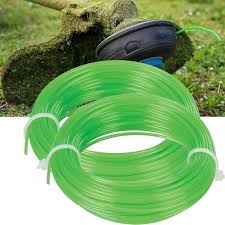Weed Eater String, When it comes to maintaining a well-manicured lawn, a weed eater (or string trimmer) is an essential tool. However, the effectiveness of your weed eater is heavily influenced by the type of string you use. With various options available, selecting the right weed eater string can make a significant difference in your lawn care routine. Here’s a comprehensive guide to help you choose the best weed eater string for your needs.
Understanding Weed Eater Strings
Weed eater strings, also known as trimmer lines, come in various materials, shapes, and sizes. They are designed to cut through grass and weeds with ease. Here are the key factors to consider when selecting a weed eater string:
- Material
- Nylon: The most common material, nylon trimmer lines are durable and can handle a variety of grass types. They are flexible, which helps them withstand impacts with hard surfaces.
- Composite: Some strings are made from a blend of materials, including nylon and additives. These strings offer enhanced durability and are less likely to break under pressure.
- Metal: For heavy-duty applications, metal lines are available. These are suitable for tackling thicker vegetation but are less common and can be harder on the trimmer.
- Shape
- Round: Round strings are the most common and are good for general use. They provide a smooth cut and are less likely to snag or break.
- Square: Square strings have sharper edges and are designed to provide a more aggressive cut. They are ideal for tougher weeds and thicker grass.
- Star-shaped: These strings have multiple points and are designed for enhanced cutting performance. They are useful for high-density weed areas and for achieving a cleaner cut.
- Diameter
- Thin (0.065 to 0.085 inches): Best suited for lightweight trimmers and less aggressive cutting. Ideal for small yards and lighter weeds.
- Medium (0.090 to 0.105 inches): A versatile option that works well for most residential and light commercial applications.
- Thick (0.110 inches and above): Designed for heavy-duty trimmers and challenging vegetation. These are suitable for large areas and tougher jobs.
- Trimmer Compatibility Ensure the weed eater string you choose is compatible with your trimmer model. Some trimmers are designed to work best with specific string types and diameters. Consult your trimmer’s manual or manufacturer recommendations to avoid issues.
Tips for Using Weed Eater String
- Check for Wear and Tear: Regularly inspect your weed eater string for signs of wear and replace it as needed. A dull or broken string can affect performance and potentially damage your trimmer.
- Proper Loading: Follow the manufacturer’s instructions for loading the string into your trimmer. Incorrect loading can lead to inefficient cutting and may damage the trimmer.
- Adjust String Length: For optimal performance, keep the string at the recommended length. Too short a string can reduce efficiency, while too long a string can lead to excessive wear.
- Maintenance: Keep the trimmer and string clean from debris and grass clippings. Regular maintenance will prolong the life of both your trimmer and the string.
Conclusion
Selecting the right weed eater string can greatly impact the efficiency and effectiveness of your lawn maintenance. By considering the material, shape, diameter, and compatibility of the string, you can ensure a better cutting performance and a healthier lawn. Always remember to follow manufacturer guidelines and perform regular maintenance to get the most out of your weed eater. With the right string, your lawn care routine will be more efficient and enjoyable.
You Might Also Like These:
does horny goat weed work instantly



